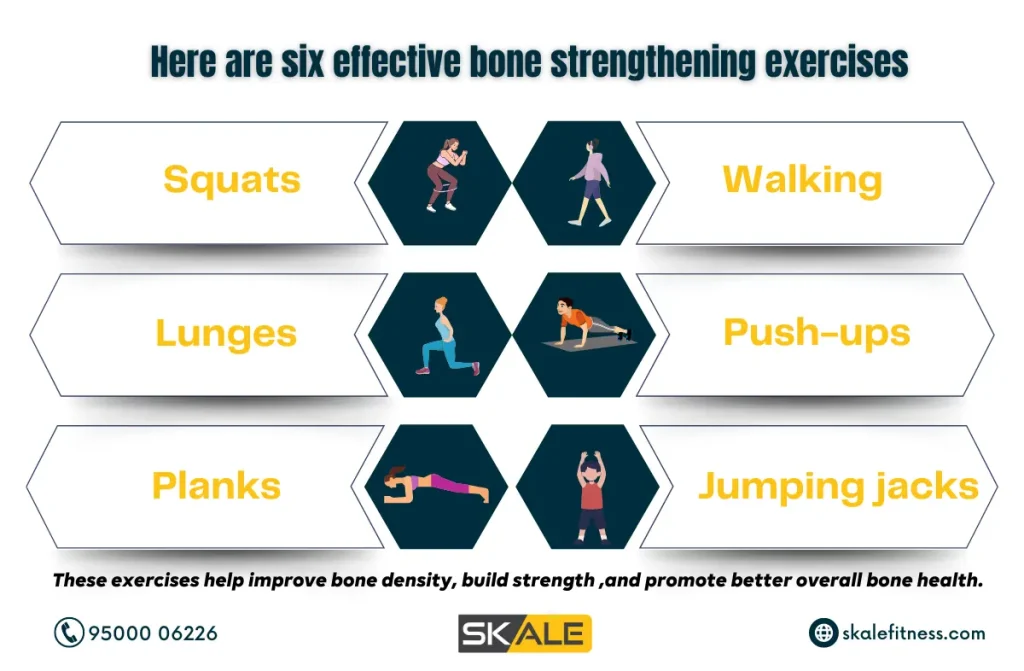Bone health is crucial for maintaining mobility, strength, and overall well-being, especially as we age. Focusing on bone strengthening exercises can help protect against conditions like osteoporosis and improve overall physical health. But which exercises are the best for strengthening your bones? In this blog, we’ll explore everything you need to know about maintaining strong bones through exercise and movement.
Exercise for Your Bone Health
Bone strengthening exercises are a vital component of a healthy lifestyle. They help you build and maintain strong bones, which are essential to prevent fractures, improve posture, and support an active life as you grow older. Let’s dive deeper into how exercise impacts your bone health.
How Does Exercise Improve Bone Health?
Regular physical activity helps stimulate bone formation and prevents bone loss. Bones are living tissues that constantly change. Exercise creates resistance on bones, signaling the body to deposit calcium and other minerals to increase bone strength. Engaging in activities that involve weight-bearing and resistance encourages stronger bones by activating bone cells, keeping them dense and healthy.
Some key ways exercise helps
- Increases bone density
- Improves balance and coordination, reducing the risk of falls
- Enhances posture and spinal alignment

Which Exercises Are Best for Keeping Bones Healthy?
When it comes to bone strengthening exercises, not all activities are created equal. Specific movements target the bones by applying the right amount of stress to stimulate growth. Here are some examples of effective exercises:
- Weight-bearing exercises: These include walking, running, hiking, and dancing, where your bones support your body’s weight.
- Resistance exercises: Using resistance bands, free weights, or machines helps to challenge your muscles and bones.
- Balance exercises: Strengthening your core and improving coordination can reduce the likelihood of falls, protecting your bones in the long run.
How Much Exercise Do We Need to Keep Bones Healthy?
It’s recommended that adults get at least 150 minutes of moderate-intensity aerobic activity, like walking or cycling, every week, along with muscle-strengthening activities on two or more days a week. For bone health, weight-bearing exercises combined with strength training will yield the best results.
Spine Strengthening Exercises for Osteoporosis
Osteoporosis weakens bones, particularly in the spine. If you’re concerned about your spinal health, it’s important to incorporate spine strengthening exercises for osteoporosis into your routine. These exercises target the spine, improve posture, and build bone density, which can prevent fractures and compression.
Some effective spine-strengthening exercises include:
- Bridges: Strengthens your lower back and glutes.
- Planks: Builds core strength and stabilizes your spine.
- Superman Pose: Lying on your stomach, lift your arms and legs simultaneously to strengthen the back muscles supporting the spine.
Weight-Bearing Activities for Stronger Bones
Weight-bearing exercises force you to work against gravity, which benefits bone strength. They can be as simple as brisk walking or as challenging as running or hiking uphill. The goal is to engage in exercises where your bones carry the weight of your body, stimulating growth and strengthening bones.
Examples of weight-bearing exercises
- Walking or Jogging: Simple yet effective for bone strength.
- Stair Climbing: Forces you to lift your body weight against gravity.
- Hiking: A fun way to add some extra intensity and resistance to your workout.
Resistance Training A Powerful Bone Builder
Resistance training is one of the most effective types of bone strengthening exercises because it involves muscle contractions that pull on bones, encouraging them to become stronger. This type of exercise can also be easily modified for all fitness levels.
Some excellent resistance exercises include:
- Squats: With or without weights, squats target the legs, hips, and back.
- Push-ups: Engaging the arms, chest, and core, push-ups are great for upper-body strength.
- Resistance Band Exercises: Easy to do at home, resistance bands allow you to work various muscles and improve bone strength.
Exercises for Strong Bones Focus on the Core
A strong core is essential for balance and posture, which reduces the risk of falls. Core-strengthening exercises target the muscles around the abdomen, lower back, and pelvis, which play a critical role in supporting your spine and overall bone health.
Key exercises for building a strong core include:
- Planks: Strengthens your entire core and stabilizes your spine.
- Bicycle Crunches: Works both your abdominal muscles and back.
- Leg Raises: Builds strength in the lower abdomen and hips.
Balance Exercises Preventing Falls
For older adults, one of the biggest risks to bone health is falling. Balance exercises not only help improve coordination but also ensure you can move confidently without stumbling.
Try these simple balance exercises:
- Heel-to-toe walking: Place your heel in front of your toes as you walk to challenge balance.
- Single-leg stands: Practice standing on one leg for a few seconds at a time to strengthen stability.
- Tai Chi or Yoga: These gentle activities focus on slow, controlled movements that enhance balance.
Stretching for Bone Health
Stretching plays a key role in bone strengthening exercises. While it doesn’t directly build bones, it improves flexibility, reduces the risk of injury, and allows for better posture and muscle support, all of which are important for overall bone health.
Some helpful stretches include:
- Hamstring Stretch: Keeps the back of your legs flexible, reducing strain on your spine.
- Quadriceps Stretch: Stretching the front of your thighs prevents tightness, which can impact your knees and lower back.
- Chest Stretch: Opens up the chest and improves posture, which is essential for spine health.
How to Rebuild Bone Density Through Exercise
Loss of bone density, particularly as we age, is a common issue. Fortunately, consistent bone strengthening exercises can help rebuild lost bone density. Resistance training, weight-bearing exercises, and regular physical activity are key to improving bone health and density.
To rebuild bone density:
- Start with low-impact activities if you’re new to exercising or have joint issues.
- Gradually increase intensity, especially with resistance training, to continually challenge your bones.
- Maintain consistency in your routine, aiming for at least three to four days of targeted exercises per week.
Foods that Support Bone Health
Alongside bone strengthening exercises, a healthy diet rich in calcium, vitamin D, and other essential nutrients is crucial for keeping bones strong. You can boost your bone health by including superfoods that promote bone density and strength.
Three superfoods for strong bones include:
- Dairy products: Rich in calcium, essential for bone health.
- Leafy greens: Full of calcium, vitamin K, and other minerals.
- Fatty fish: High in vitamin D, which aids calcium absorption.
Conclusion
Incorporating bone strengthening exercises into your routine is one of the best ways to ensure strong bones, prevent injury, and enjoy an active life well into old age. Whether you’re walking, weightlifting, or practicing yoga, keeping your bones in top shape is a smart investment in your health.




